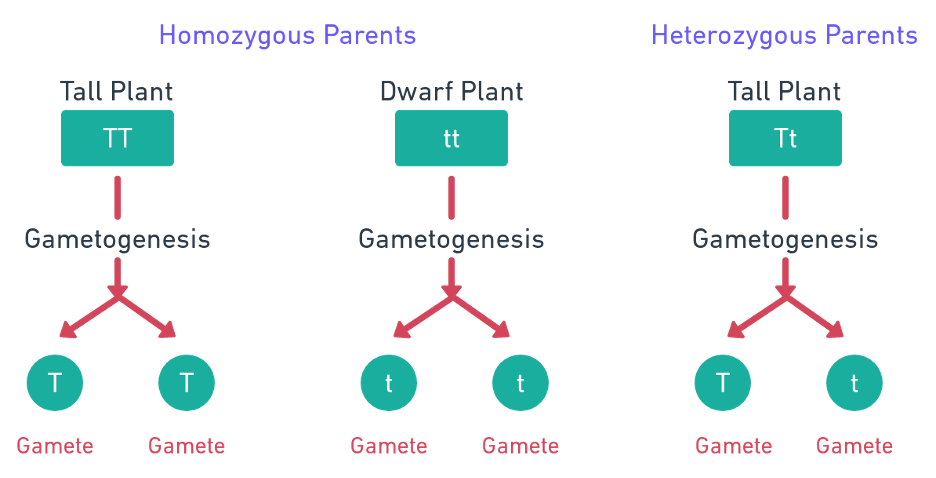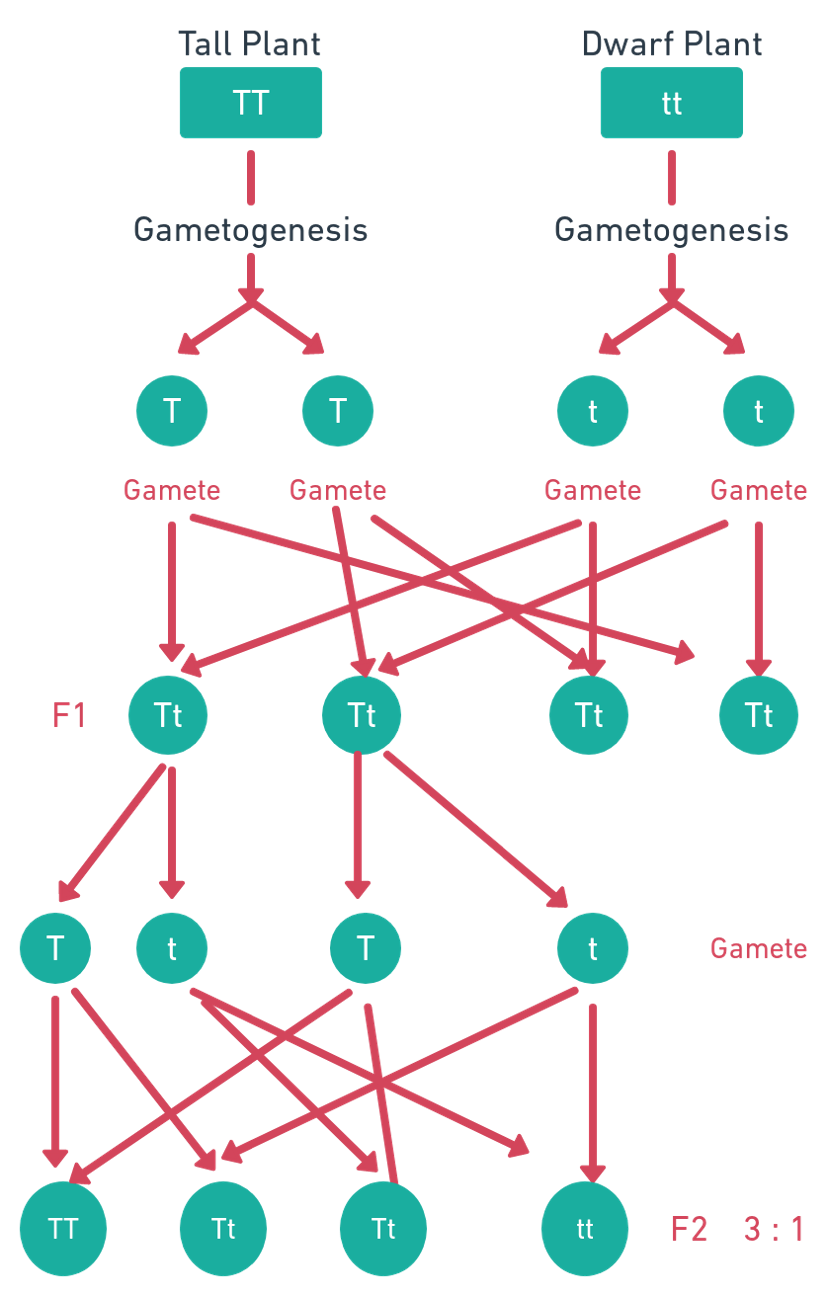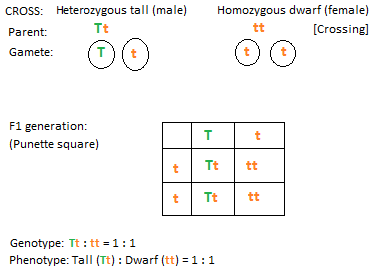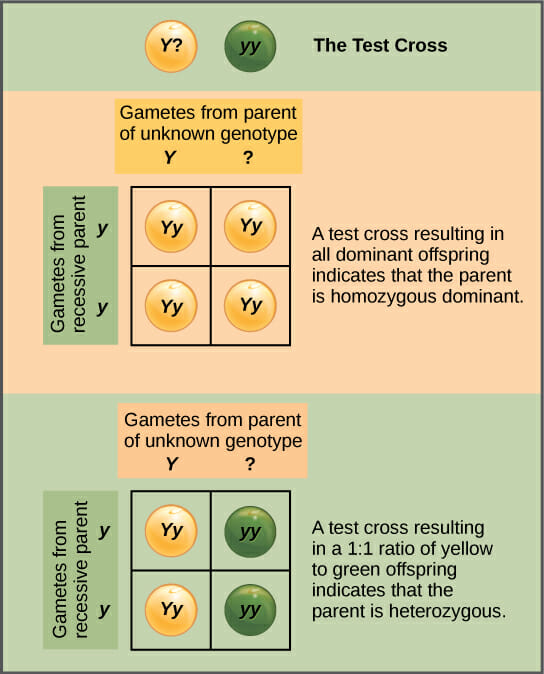👨⚖️ Mendel's Laws
Mendel's work, Law of Segregation, Dominance, Independent Assortment
Mendel’s Laws
Mendelis known as Father of Genetics.- Theory of Inheritance given by
Mendel. UPPSC 2021
Mendel’s Work
- Mendel selected the garden pea (Pisum sativum L) for his experiment. He found the garden pea plant as the most suitable material because of
- The garden pea was easy to culture either in field or in pot.
- It had shorter life cycle or was of short duration.
- It had highly self-pollinated flowers.
- Well defined contrasting heritable characters.
- Easy emasculation & hybridization.
- Mendel selected seven pairs of contrasting characters for his study.
Table: Seven pairs of contrasting characters studied by Mendel

- Before Mendel’s work, several workers conducted the heredity experiment i.e. hybridization work, but they were failed. Those workers considered the individuals as a whole complex of characters.
- Whereas Mendel’s success was mainly based on the fact that he
selected a single character at one time.
Reason for Mendel’s success
- Considered one trait (character) at one time.
- Selected contrasting (opposite) pairs of characters i.e. 7.
- All the characters were independent of each other.
- Characters were present on different chromosome i.e. there were no linkages.
- Accurate account of experiment.
- Used appropriate symbol, sign & terminology.
Mendel’s observations
- Mendel crossed the tall plants with dwarf plants.
- All the pants of F1 generations were tall. The initial cross between two varieties is called the parental or P1 generation and their offspring whether in seed form or as plants are called the F1 (Filial) generation. The succeeding generations produced from the crossing of F1 are called F2 generation and so on.
- When Mendel self-fertilized the F1 plants, the offspring were both tall and dwarf plants in the ratio of
3 : 1. He found that the similar patterns were also observed in other six contrasting traits. He also found that the reciprocal crosses gave the same results i.e. pollen or egg of the parent variety did not matter.

👉🏻 Although Mendel did the brilliant work but due to the following reasons, his work was not recognized till 1900 A.D.:
- Due to predominance and wider acceptability of the Darwin’s theory of continuous variations, the workers of that time were unable to understand the principle of heredity.
- Due to the use of mathematical calculations and probability law, his works were not accepted by the biologists.
- The biologists did not know the chromosomal behaviour and the phenomenon of fertilization.
- He did not publish his works in the leading journals.
- He failed to proof his experiment on Hieraceum as suggested by Prof. Nageli.
Mendel’s Laws
- Mendel’s works were confirmed & rediscoverd in
1900individually by Hugo de Vries (Dutch), Carl Correns (German) & Erich Von Tschermark (Austrian). Then three fundamental principles of genetics were universally accepted.
- Law of segregation or purity of gametes.
- Law of Dominance or Law of uniformity of first filial generation.
- Law of Independent assortment.
Law of Segregation or Purity of gametes
- In heterozygous state, the dominant and the recessive alleles remain together throughout the life without contaminating or mixing with each other. During gametes formation these alleles separate or segregate from each other so that each gamete gets only dominant or recessive allele.
- For understanding the law of segregation, here are four principles:
- Hereditary character is determined by a particular factor (now called gene)
- These factors occur in pair i.e. each gene has two or more alternative forms, known as alleles.
- In the formation of gametes, these factors are separated in such a manner that only one of the pair is transmitted to a particular gamete.
- When male & female gametes unite to form a zygote, the double of the chromosome number is returned.
Homozygous and Heterozygous

- The individual being identical alleles at both gene loci for a particular phenotypic character is called homozygous individual.
- The individual or genotype having different allele for a particular trait is called heterozygous individual or genotype.
- Hemizygous: An individual having only one allele of a gene in place of normal two allele is called hemizygous individual.
👉🏻 Mendel’s observations
- After selfing of pea plant for several generations, Mendel observed that only tall progenies from the tall plant and only dwarf progenies from the dwarf plant were obtained.
- It means the parent plants were in homozygous state i.e. the alleles of tall plants would be TT and of dwarf plants would be tt.
- During the gametogenesis homozygous tall plants (TT) would produce only (T) type of gametes and homozygous dwarf plants (tt) would produce only (t) type of gametes.
- But heterozygous plants (Tt) would produce both types of gametes i.e (T) type and (t) type but in pure form.
- Number of gametes = 2n (n = number of ……)

- In heterozygous tall plant (Tt) the tall (T) allele is dominant over the dwarf (t) allele, therefore the plant will be tall but during gamete formation both the alleles (T) and (t) separate from each other and form the pure gametes.
Law of Dominance
- Mendel observed that the F1 individuals derived from the crosses between two different varieties having different characters, showed only one of traits & never the other. Such trait in F1 generation was called dominant and the other which did not appear in the F1 generation but reappeared in F2 generation was called recessive.
- Mendel was fortunate to select seven pair of contrasting characters which exhibited dominance.
- Now it is clear that the hybrid of F1 generation always be uniform, therefore the law of dominance can be renamed as
law of uniformity of first filial generation.
- In F1, all plants were tall.
- In F2, Tall : Dwarf = 3 : 1.
Law of Independent Assortment
- According to this law, segregation and assortment of alleles for different characters are independent to each other and follows the multiplication of law of probability. But this principle is applicable only on the alleles of genes located on the different chromosomes and not to the linked genes.
- Mendel crossed two varieties of pea i.e. yellow colored round seeded plant with green colored wrinkled seed plant. The F1 seeds obtained were yellow colored & round seed yellow is dominant over green and round is dominant over wrinkle.
- In F2 generation. Four types of seeds were obtained in the ratio of
9 : 3 : 3 : 1. This ratio was also expected from independent segregation of seed shape and cotyledon color. From the Mendel’s observation it is concluded that seed shape and cotyledon color segregate independently of each other.
- The method of working out F2 progeny using different kinds of male & female gametes is known as checkerboard.
Table: Summary of the genotypes and phenotypes obtained in F2 of the cross shows in the Fig.

Deviations from Mendel’s law
- Mendel found that each of 7 characters considered was controlled by a single gene but there may be more than or equal to 2 genes responsible for a particular character.
- According to Mendel, one allele dominates over the other and the phenotypic ratio in F2 is 3:1 but in Mirabilis jalapa is 1 (Red) : 2 (Pink) : 1 (White) when red flower plant is crossed with white flower plant.
- According to Mendel, there were only two alternative forms for each character means only two alleles were present for each character but there may be several phenotypes for a character. Therefore, concept of alternative allelomorphs has been modified by the concept of multiple allelism. Existence of more than two alleles at a locus is called multiple allele e.g. several alleles exhibit red eye colour (W+s, W+C, W+g) in Drosophila.
Monogenic/Monohybrid cross
- Here only one pair of contrasting character was taken.
- The ratio in F2 generation were
- Genotypic ratio: 1 : 2 : 1
- Phenotypic ratio: 3 : 1
Dihybrid cross:
- Here two pairs of contrasting characters were taken.
- The ratio in F2 generation were
- Phenotypic ratio: 9 : 3 : 3 : 1 (Four types)
- Genotypic ratio: 1 : 2 : 2 : 4 : 1 : 2 : 1 : 2 : 1 (9 types)
Trihybrid cross:
- Three pairs of contrasting characters will show
- Phenotypic ratio: 27 : 9 : 9 : 9 : 3 : 3 : 3 : 1
- F1 will produce 8 kinds of gametes & 64 combinations in F2.
Back cross
- Usually F1 individuals obtained from the cross between the parents are selfed to get F2 progeny.
- But when the F1 individual is crossed with either of the two parents, such cross is known as
back cross.
Test Cross
- When the F1 individual is crossed with
recessive parent only, is called test cross.

- The test cross is used to determine the genotype of the parent whether an individual is homozygous (means pure) or heterozygous (hybrid).
Example:

Mendel’s Laws
Mendelis known as Father of Genetics.- Theory of Inheritance given by
Mendel. UPPSC 2021
Mendel’s Work
- Mendel selected the garden pea (Pisum sativum L) for his experiment. He found the garden pea plant as the most suitable material because of
- The garden pea was easy to culture either in field or in pot.
- It had shorter life cycle or was of short duration.
- It had highly self-pollinated flowers.
- Well defined contrasting heritable characters.
- Easy emasculation & hybridization.
- Mendel selected seven pairs of contrasting characters for his study.
Table: Seven pairs of contrasting characters studied by Mendel

- Before Mendel’s work, several workers conducted the heredity experiment i.e. hybridization work, but they were failed. Those workers considered the …
Become Successful With AgriDots
Learn the essential skills for getting a seat in the Exam with
🦄 You are a pro member!
Only use this page if purchasing a gift or enterprise account
Plan
Rs
- Unlimited access to PRO courses
- Quizzes with hand-picked meme prizes
- Invite to private Discord chat
- Free Sticker emailed
Lifetime
Rs
1,499
once
- All PRO-tier benefits
- Single payment, lifetime access
- 4,200 bonus xp points
- Next Level
T-shirt shipped worldwide

Yo! You just found a 20% discount using 👉 EASTEREGG

High-quality fitted cotton shirt produced by Next Level Apparel